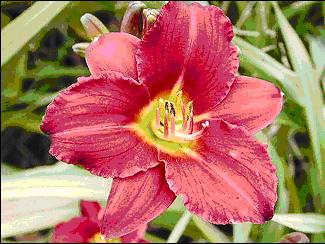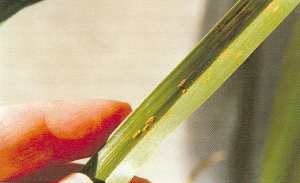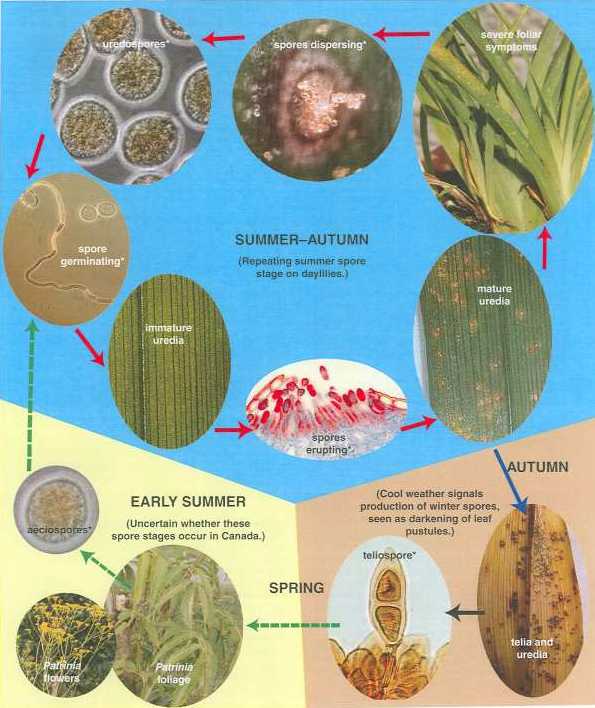Daylily rust
Learn symptoms, life cycle, hosts, variety susceptibility, and disease management options for daylily rust.
Introduction
Daylilies (Hemerocallis sp.) are one of the top-selling herbaceous perennials in North America. As members of the Liliaceae family, daylilies produce showy lily-like flowers that bloom in clusters, for one day before senescing (Figure 1). Daylilies are native to the Old World from central Europe to China and Japan. Most selections available to North American gardeners are cultivated hybrids of original species. Daylilies are most often propagated by crown divisions in spring or fall. These divisions are transplanted into the field or containers for further growth until sale. Daylily cultivation and breeding has become exceptionally popular, with the formation of strong national and provincial/state chapters across North America. Originating in Asia, daylily rust (Puccinia hemerocallidis) was first discovered within North America in the southern United States during 2000. The disease quickly spread and was found in various locations throughout the United States and in Canada during 2001. Daylily rust threatens the production and cultivation of daylilies in North America. Proper identification and understanding the biology of the disease is critical for successful disease management.

Symptoms
Daylily rust is caused by a fungus, Puccinia hemerocallidis. This fungus will only infect and colonize green, live host tissue (Figure 2). It can infect leaves and scapes (leafless, flower stems) of daylily plants but not roots or crowns. Under conditions favourable for disease development, symptoms appear 3–7 days after infection. Symptoms on very susceptible varieties appear as small, yellow-orange, oval-shaped pustules (Figure 3, immature uredia). The chlorotic areas between the pustules often coalesce and become quite pronounced on more susceptible varieties (Figure 3, severe foliar symptoms). On less susceptible varieties, pustules are not as numerous and are surrounded by tan-brown, dead leaf tissue. The pustules contain hundreds of rusty coloured summer spores (uredospores). These spores can easily be transported by wind or rubbed off onto clothing, boots or tools. It is these summer spores that cause repeat infections on neighbouring daylily leaves and scapes throughout late summer and into autumn. The fungus requires living green tissue to continue to grow and produce the rust-coloured summer spores. In the autumn, before leaves begin to senesce or die naturally, new infections will produce dark brown to black pustules that contain the resting or winter spores (Figure 3, teliospore).


Biology and life cycle
The biology of the fungus P. hemerocallidis is complex and requires 2 different plant host species and 5 different rust spore types to complete a life cycle (Figure 3). In the spring, the dark winter spores (teliospores) germinate and produce another set of spores, which can only infect the alternate host, Patrinia spp. On Patrinia, 2 more spore stages are found with their own distinct symptoms (Bergeron, 2004). In summer, spores produced from Patrinia can infect daylilies. These infections result in yellow spots called uredia which produce the repeating summer spores (uredospores), that re-infect daylilies. Several cycles of re-infection can occur weekly if conditions for rust infection and development are favourable. With cooler temperatures and leaf senescence, the uredia stop production of uredospores and begin to produce the dark, winter spores called teliospores. During this transition, both teliospores and uredospores can be found in the same pustules, which begin to darken as more teliospores are produced. The masses of teliospores (called telia) overwinter, and germinate in the spring to continue the life cycle. Again, the telial stage of this fungus is likely not required for the disease to continue on into the next growing season. The fungus may be able to survive on varieties that maintain green leaf tissue during the winter, on plants brought indoors, or on plants overwintering in a minimum-heated greenhouse.
Alternate host
The alternate host for daylily rust is the herbaceous perennial Patrinia spp. Patrinia is found in the Valerianaceae family and is sometimes referred to asElvis-eyes or Golden Valerian (Figure 3 Patrinia). Patrinia spp. have small yellow flowering clusters that grow from a clump of palmately-lobed leaves, and are often used in lightly or partly shaded gardens. The plants are native to Asia, but several species including P. gibbosa, P. triloba, P. villosa and P. rupstris are sold in the United States as well as in warmer regions of Canada. Patrinia is not a common perennial in North American gardens and likely poses little threat to the spread of this disease in the landscape. However, there is still some uncertainty about the role of Patrinia in the disease cycle of daylily rust in North America. There is very little information regarding the survival of daylily rust in northern temperate regions such as Canada. However, the disease may not require the alternate host, Patrinia spp., since the fungus may be able to survive on varieties which maintain green leaf tissue during the winter, on plants brought indoors, or on plants overwintering in a minimum-heated greenhouse.
Environmental conditions for disease development
In Ontario, daylily rust is not usually observed until the latter part of summer and early autumn. Studies have shown that the optimal temperatures for summer spore germination can occur at 22–24°C under high humidity (although germination can occur from 7–34°C). Summer spores do not germinate in cold (≤4°C) or extremely warm temperatures (≥36°C) and this disease is not severe during hot, dry or cold conditions. A minimum of 5–6 hours of continuous leaf wetness is required for spore germination and leaf infection. In addition, summer spore germination decreases with high light intensity. Under conditions favourable for disease, hundreds to thousands of summer spores from each infected leaf can be produced quickly and spread rapidly, making this disease a serious threat to daylilies. This phase of the disease cycle can repeat itself many times during periods of warm weather with rain or dew periods, resulting in disease epidemics.
Variety susceptibility
Daylily rust does not necessarily kill plants but can affect plant vigour, susceptibility to other pests and marketability. Differences in cultivar susceptibility to daylily rust have been observed in experiments conducted at the University of Georgia and the University of Guelph. However, a limited number of cultivars have been evaluated and more research into cultivar susceptibility and resistance is required. Varieties known to be very susceptible (many pustules containing numerous summer spores) include: 'Buttercup', 'Catherine Woodbury', 'Cherry Cheeks', 'Colonel Scarborough', 'Couble', 'Imperial Guard', 'Irish Ice', 'Ming Toy', 'Pardon Me', 'Karie Ann', 'Lemon Yellow', 'Little Gypsy Vagabond', 'Pandora's Box', 'Quannah' and 'Russian Rhapsody'. Moderately susceptible (fewer pustules frequently surrounded by dead brown-tan coloured leaf tissue and containing fewer summer spores) varieties include: 'Butterflake', 'Condon', 'Crystal Tide', 'Gerturde', 'Happy Returns', 'Prelude to Love', 'Joan Senior', 'Pandora's Box', 'Rosy Returns', 'Star Struck', 'Stella D'Oro', 'Summer Wine', 'Wilson's Yellow' (and Hemerocallis fulva). Low susceptibility (little to no infection) varieties include: 'Butterscotch Ruffles', 'Holy Spirit', 'Mac the Knife' and 'Yangtze'.
Diagnosing daylily rust
If you suspect your plants have been infected with daylily rust, reduce the chances of spreading this disease by placing a large, clear plastic bag over the symptomatic foliage and obtain leaf samples from within the confines of the bag. Close the bag tightly around the base of the plant and remove as much infected foliage as possible inside the bag. Take the samples indoors where foliage can be examined more closely. Raised, orange pustules can be seen with the naked eye on both the upper and lower leaf surfaces but may be more prevalent on the lower leaf surfaces of some varieties. Pustules are more easily viewed with a 10–20x magnification hand lens. Immature pustules are elliptical, raised bumps with a waxy sheen and a yellow-orange color. Mature pustules have a protruding mass of orange, powdery spores. The spores can be easily rubbed off onto fingers (Figure 2). Submit a sample to the local Pest Diagnostic Clinic for conclusive identification (see References).
Disease management
- Avoid growing Patrinia spp. in nurseries or gardens where daylilies are grown. Spores produced on Patrinia spp. are thought to be infective to daylilies. If the different hosts are in close proximity, then the chances of infection are greater.
- Scout daylily plants frequently during the later weeks of summer, particularly after rain, when conditions are favourable for dew formation or during a prolonged period of cloudy days with day time temperatures around 22–24°C.
- Select and grow the least susceptible varieties in regions where daylily rust has been found.
- Avoid overhead irrigation. To minimize leaf wetness periods, direct irrigation to the soil surface and not the leaf canopy. Divide daylilies every 3–5 years and keep plants well spaced to facilitate leaf drying after rain or irrigation. If possible, irrigate plants in the morning to allow for quick drying of foliage during the day, rather than watering in the evening.
- If daylily rust is confirmed, cover infected plants with a large, clear plastic bag and remove all leaves and scapes from the infected and surrounding plants as close to the ground as possible. Composting of diseased tissue is not recommended at this time since it is not known how long the summer spores will survive under composting conditions or whether they may blow out of the compost pile and infect healthy plants nearby. Diseased tissue should be placed in a plastic bag and promptly removed from the area. Use disposable rubber gloves and wash clothing after working with or around diseased plants.
- Use registered fungicides to help protect healthy plants from rust infection. Fungicide applications should begin in early summer and may terminate when daytime temperatures do not exceed 7°C. If plants become infected but are not yet producing powdery spore masses, systemic fungicides may be able to cure the infections and prevent pustule development. To obtain information on registered pesticides to manage daylily rust in Canada, please consult the Pest Management Regulatory website. Search "Product Information" by entering the name of the pest you wish to search for in the database."
- In the autumn, cut plants back to remove all green foliage. Do not mulch as mulching infected plants may protect rust pustules that have gone unnoticed and possibly allow them to survive the winter.
References
- Bergeron, S. 2004. Daylily Rust Information Page.
- Hsiang, T., Cook, S., and Zhao, Y. 2004. Studies on the biology and control of Daylily Rust in Canada. The Daylily Journal 59(1):47-57.
- Mueller, D.S., and Buck, J.W. 2003. Effects of light, temperature and leaf wetness duration on daylily rust. Plant Disease 87:442-445.
- Ontario Daylily Society
- Pest Diagnostic Clinic
95 Stone Rd. West, Guelph, Ontario N1H 8J7
Tel: (519) 767-6256; Fax: (519) 767-6240 - Williams-Woodward, J.L., and Buck, J.W. 2001. Daylily rust (Puccinia hemerocallidis) in the United States.
Acknowledgements
Photos of teliospores and uredium were provided courtesy of George L. Barron. The photo of the senescent leaf with telia was provided courtesy of Susan Bergeron and the photo of the 'Pardon Me' flower was provided courtesy of Suzanne Johnston. The authors provided all other photos.